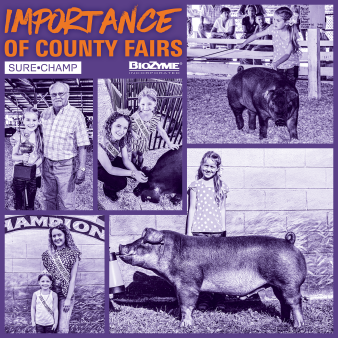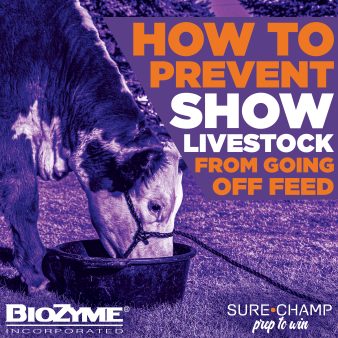
Showing pigs is fun. Nothing is quite as rewarding as getting the slap or handshake indicating that months of hard work have paid off with a championship. And much of that work is the science behind feeding the right diet to your pigs.
Diet, exercise, skin and hair are all integral parts of prepping to win in the ring. When it comes to showing any species, starting with good genetics and a structurally sound animal that has good phenotype and a great disposition is a solid foundation. Combine that with a good nutrition program, and you’ve won half the battle! That’s why the Sure Champ® Team created this show pig feeding guide.
At Sure Champ, we are passionate about our own show livestock projects. We spend countless hours in chip barns sorting baby pigs, looking for the ideal show pig prospect. Once we get those little pigs home, we determine days on feed and calculate the right rations. At BioZyme®, makers of Sure Champ, our team is made up of people just like you.
At Sure Champ, we know champions are made at home. There is a champion inside every exhibitor. It takes fortitude and knowledge to succeed. We hope you find this show pig feeding guide useful as you #PreptoWin.
Show Pig Feeding Guide
Feeding show pigs is a science. You need to have your endpoint in mind, know how many days you have to reach that date and know the daily gain of each pig you are feeding. Since most people pen their pigs separately for safety and well-being it also makes sense to feed them individual rations tailored to their muscle development and finish.
Keep them Eating
Feeding your pig is a big part of the success of showing pigs. Keeping them on feed is vital, and keeping them hydrated is key to keeping them eating.
Water is the most essential nutrient for all livestock. Although different watering systems are available, from gravity flow to a pressure system, the most important thing to remember is to keep water fresh, clean and available at all times. In the winter, make sure your pipes don’t freeze, and if the water system relies on electricity, make sure that the power source is always working.
You eventually will want to feed each show pig about 4 to 8 pounds daily, split into two equal feedings. We recommend feeding your animals as close to 12 hours apart as possible and on a consistent schedule. For example, if you feed them at 7 a.m., feed again at 7 p.m., and keep that schedule. Observe them as they eat and watch for anything unusual. Give them an allotted amount of time to eat, and after that time, if they don’t finish, take their feed away from them. This teaches them not to “play” with their food and to be efficient eaters.
Getting Started
When it comes to feeding, you have lots of options. Each exhibitor or feeder will likely find his or her feed of choice based on experience, recommendation, convenience or price. When you first bring young show pig prospects home, start them on a starter feed that contains 16-25% protein. Find out what your new show pig has been eating. If you buy multiple pigs from the same breeder, try to get a bag of that feed for your feed room.
Sometimes the breeder will send a few pounds of feed home with you to help the pigs make an easy transition from their feed to your preferred feed. A gradual transition is best. Since your pig is already experiencing some stress in a new environment, give it a few feedings of the feed it is already familiar with. Then start mixing half of its familiar feed with half a feeding of the feed you want to introduce it to. Give it two feedings like this. If you can, then mix a 75/25 mix for two feedings. Finally, transition it to 100% of the new feed.
A transition schedule might look like this:
- Day 1: Familiar Feed: 100%
- Day 2: Familiar Feed: 100%
- Day 3: Familiar Feed: 50% – New Feed 50%
- Day 4: Familiar Feed: 25% – New Feed 75%
- Day 5: New Feed: 100%
Nutrition Matters
This show pig feeding guide has addressed a lot about how to feed, but let’s talk more about what to feed. We know there are several choices of brands, and we’ll let you decide on the base of your ration. But let’s discuss how important nutrition is to your show pig’s overall success.
In the ring, judges evaluate show pigs on muscle, correctness of finish, structure, balance and overall eye appeal. Nutrition influences all of these areas. Pig feed is often meal or pelleted to increase palatability and reduce the occurrence of stomach ulcers.
In addition to water, pigs require protein, energy, fat, vitamins and minerals to grow, develop muscle and thrive in the show barn and in the show ring. Since we already mentioned water, let’s discuss the other key nutrients show pigs need in their diets:
Protein
Protein is the building block of muscle development and repair in show pigs. Additionally, protein supports hair, hooves, skin and internal organ development. The predominant protein source in a growing and finishing show pig diet is soybean meal.
One important idea to understand when evaluating show pig feed is the difference between crude protein (CP) and amino acids. Pigs don’t have a true requirement for CP but do require individual amino acids. Amino acids are the building blocks that make up crude protein. There are 22 different amino acids, 10 of which are “essential.” Since pigs don’t produce amino acids, you have to supply them with feed.
When reading feed tags and building a show pig diet, it is important to look at amino acid inclusion and levels. Of the essential amino acids in the diet, lysine has the highest priority in pig diets. If a pig’s diet doesn’t include the proper amount of lysine and other essential amino acids, it develops more slowly. A lysine deficiency can also cause decreased muscle development and increased fat deposition. Always look for the total lysine percentage on the tag, .08% – 1.2%.
Energy
Carbohydrates are the primary energy source in a show pig’s diet. Energy is crucial to help support proper maintenance, growth and movement. Carbohydrate sources include corn, barley, wheat and oats.
Fat
Fat serves as a secondary energy source next to carbohydrates. Dietary fat sources provide two to three times more energy than carbohydrates or proteins but are comparably expensive. This results in less quantities of them in feed. Dietary fat comes in solid or liquid forms and pigs can get more of it via animal or plant sources.
Vitamins & Minerals
Just like you take your daily vitamins, show pigs need theirs, also. Even though they represent a small percentage of the diet, vitamins are extremely important for the support of normal body functions:
- B vitamins assist with eye, skin, teeth and bone health.
- Vitamin C is an antioxidant. It supports tissue growth and stress reduction.
- Vitamin A heals wounds and boosts immunity.
- Vitamin D supports bone and teeth health.
- Vitamin E supports immunity and reproductive function.
- Vitamin K keeps blood clotting correctly.
Similar to vitamins, minerals are included in small amounts in the diet. Minerals play a crucial role in bodily functions including, structural support and development, metabolic functions and regulatory functions. Mineral requirements are divided into two categories based on mineral type.
Microminerals are included in the smallest amounts and include minerals such as zinc, copper, iron, manganese, iodine and selenium. Macrominerals are included in slightly larger amounts and include calcium, phosphorus, potassium, magnesium, sodium and chloride.
Since some feeds don’t include the essential vitamins and minerals needed, we recommend a complete vitamin and mineral supplement for your show pig.
Speaking of Supplements
In addition to vitamin and mineral supplements for your show pig, there is an entire suite of supplements for the show pig world. You can find supplements to add shape, take away shape, add freshness, help with skin, increase joint flexibility, burn fat and more. However, when it comes to supplements, Sure Champ is your one-stop solution.
Sure Champ Offers a Page to your Show Pig Feeding Guide
Sure Champ is a line of products that supports the health and well-being of show livestock. This product line is powered by AO-Biotics® Amaferm®, a prebiotic research-proven to enhance digestibility. Sure Champ products help keep your animal healthy and performing by enhancing their digestive system. Since we know that 70% of the immune response is found in the gut, if your animal’s digestive system is healthy, the rest of it will also be healthy.
Here are a few Sure Champ supplements we recommend:
For Occasional Stress
Sure Champ® Extreme with ClariFly®
Sure Champ Extreme with ClariFly is a pelleted, daily supplement for show livestock with Clarifly designed to support hoof health, hair coat, and performance when temperatures are above 70 degrees. Designed for all species, it contains Amaferm and MOS to help normalize gut microflora and support the immune system. It also contains HEAT technology, a combination of essential oils and garlic, as well as ClariFly to support animals when heat and insects are a challenge.
Sure Champ® Liquid Boost®
Sure Champ Liquid Boost is a liquid for all livestock designed to provide immediate support to the animal’s digestive and immune systems. Formerly known as Vita Charge Liquid Boost, it contains Amaferm and MOS and flavoring to help drive the intake of feed or water.
Sure Champ® Appetite Plus Gel
Sure Champ Appetite Plus Gel is a gel for all livestock designed to provide immediate support to the animal’s digestive and immune systems. Formerly known as Vita Charge Gel, it contains both Amaferm and MOS and works fast to support appetite and hydration.
Sure Champ® Climate Control Gel
Sure Champ Climate Control Gel is a gel for all livestock designed to support digestive health and recovery when temperatures are above 70 degrees. Formerly known as Vita Charge Climate Control, this gel contains Amaferm and HEAT technology, a combination of essential oils, to support animals when heat is a challenge. It promotes appetite and water intake.
Sure Champ® Clench Gel
Sure Champ Clench Gel is a gel for all livestock designed to support normal digestive function during occasional diarrhea/scours. Formerly known as Vita Charge Clench Gel, it includes Amaferm and MOS and contains electrolytes to support rehydration.
For Joint Health
Sure Champ® Joint Juice
Sure Champ Joint Juice is a liquid product for livestock designed to support joint health utilizing patented technology. Joint Juice contains MHB3®, a patented high-molecular-weight hyaluronic acid. It lubricates joints and supports mobility and soundness.
Stock up on Sure Champ
We hope you find this show pig feeding guide useful. Plenty of show pig breeders and nutritionists will gladly advise you along the way.
You can get your Sure Champ products by ordering online today.
Do you prefer to support a local Sure Champ dealer? Find a dealer near you to find all your favorite Sure Champ and other BioZyme products.
Want to stay current on all of our educational blogs and news? Sign up for our newsletter.

